Reading recently about Offenhauser racing engines got me to thinking about the great Harry Miller, who was perhaps America's greatest and most influential manufacturer of racing engines and racing cars of the twentieth century. He is largely forgotten today, perhaps due to his being involved almost exclusively in the production of racing machinery, and not roadgoing automobiles, as opposed to his contemporaries such as Ettore Bugatti, or the Duesenberg brothers, Fred and August. Massive and scholarly books have been written about Harry Miller's life and his life's work, so I can contribute little more to the discussion here. Instead I will pass on some excerpts from one of my favorite automotive books, "Design and Development of the Indy Car", by the great author Roger Huntington. This superbly written, and beautifully illustrated book was published first in 1981, and is still in print, I believe. Every racing enthusiast NEEDS this book in their library, especially fans who love the field of technical innovation in motorsports, which has been a hallmark of American Indycar racing from its beginning in 1911.
Harry Miller's engine designs set the standard for racing engines for decades, and became the basis of many significant offshoots in later years, most notably the timeless "Offy" Offenhauser four-cylinder powerplant that evolved through four decades into the monster, turbocharged, 1,000+ horsepower Indy 500 winner of the seventies. There is simply too much interesting history to include in this hand-typed little screed of mine. So, I am paying my tribute to Harry Miller by citing his racing swansong, and one of the most incredibly innovative and ahead-of-its-time racing automobiles ever made, the Gulf Oil/Miller 4WD (as in four-wheel-drive) Special of 1940.

True, they may have never finished a 500, or even qualified all that well. But, looking back almost seventy years, just to imagine a mid-engined (laid out quite similarly to Porsche's Auto Union GP cars), all-disc-braked, four-wheel-driven racing car is just astounding in its futuristic vision. Harry Miller may have been nearing the end of his life, but his spark of creativity never flickered; on the contrary, it burned perhaps brighter than ever.
If anyone who is interested in Miller's automobiles is ever near Indianapolis, then go and visit the Indianapolis Motor Speedway Hall of Fame Museum, which is located on the infield between Turns One and Two. The Speedway owns three Miller racing cars, and they are kept in a special, Harry Miller shrine within the exhibits. I guarantee you that these sublimely beautiful racing automobiles will take your breath away with their "Swiss watch-like" workmanship, their sheer beauty, as well as their advanced thinking in the form of front-wheel-drive, high-speed, supercharged twincam powerplants, inboard braking, etc. I have become an unrepentant "America Booster" in the past few years, and for good reason. Just as I myself, for many years, chose to ignore the greatness of America's automotive history, as here with Harry Miller, in favor of becoming chauvinistically (and snobbishly) obsessed with only the greats of Europe, it's only in recent years that I've reopened my eyes to the proud motorsports history of this country. It takes nothing away from Ettore Bugatti, Enzo Ferrari, Dr. Porsche, or any of the other legends of European motorsports to include the genius on THIS side of the Atlantic amongst them; men like Harry Miller, the Duesenbergs brothers, Fred Offenhauser, Henry Ford I (yes, Ford was a pioneer in racing automobiles as well), Zora Arkus Duntov, Jim Hall, and many other brilliant designers, engineers, and "idea men" who advanced the technology of auto racing like few others. They deserve to be honored every bit as much as the better-known personalities. This was just my small tribute to Harry Miller...Michelangelo of metal.
It's worthwhile to display a photo or two of one of the all-time beautiful automotive classics, the Cord L-29 of 1929. The reason for this is to show how the Cord, which was styled by the great designer, Alan Leamy, took its inspiration directly from the Miller racecars of the time. It was a direct inspiration, which can be seen readily in the photos. The short, setback radiator resting on the front-drive machinery, with front wheels projecting forward prominently, giving both racing and road car the look of going really fast just standing still, is obvious. Another writer once called this look "the chassis racing away from beneath the body". Both are blue-chip classics of the world's automotive heritage.
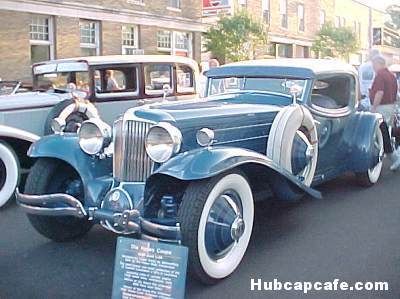
Let's take a look back a few years, into the time before Harry Miller's dominant and influential front-drive Indy racing cars of the 1920s, and examine the incredibly creative and futuristic "Golden Submarine" designed by Miller in 1917. The Golden Submarine was built expressly for the legendary racing pioneer racing driver Barney Oldfield. Miller's impetus for creating the Golden Submarine was to provide a safer car for the driver by enclosing the cockpit, along with reducing wind resistance (aerodynamics was a fledgling science in the WWI period). The windows were covered with a black screen-mesh to prevent flying objects like stones, etc from hitting the driver, which was a real hazard on racetracks of the day. Ironically, the great Oldfield hated the claustrophobic sensation of driving the "Sub", and had the roof cut away not too long after beginning his campaign with the car. The original Golden Submarine was raced, typically, in a "ride it hard and put it away wet" manner by Oldfield, and in subsequent years was lost to the ages. However, about 10 years ago or so, the original blueprints for the car were discovered, and it was recreated, from the ground-up, as a perfect replica. The "Sub" was, ultimately, merely a curiousity for its own time, but in the long view of history it holds the distinction of being the first really serious effort towards and enclosed cockpit for a racing automobile; one which provides a modicum of safety for its driver within.

Among some design enthusiasts today, there is an interest in the "wheels forward" look that is seen on the cars being discussed in this piece. Modern-day BMW automobiles frequently typify the contemporary use of this device as a way of imparting a sporty and "nimble" look to their cars, to good effect. I have always loved this type of design because it just looks dynamic and progressive. Another of the many classics that used this styling "trick" to tremendous success was the legendary Mercedes Benz 500K and 540K sports/touring automobiles of the late thirties. They are so extreme in this effect as to create a look as if the wheels are racing out from under the body. On the Mercedes Benz this effect is dramatic because of the freedom given the designers to exaggerate the look to its ultimate realization. The driver of these cars is probably 10 feet distant from the front wheels! Damn the functionality, full STYLE ahead!
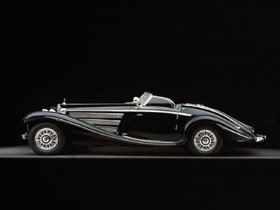
Getting back to Harry Miller's masterpieces, here are a few photos of the Gulf Oil Miller 4WD Special of 1939. The detail shot gives a closer look at the early and unusual type of disc brake that the car was equipped with. The car may look a little bit "clunky" to eyes unaccustomed to the times, but this car was highly advanced and every bit as sophisticated as any of the vaunted German Grand Prix machines of the era. It just didn't get a chance to reach its potential, because the funding dried up along with the interest, unfortunately, as positive results didn't come as immediately as expected. (BTW, the boxlike object mounted ahead of the left rear wheel is the air-to-air intercooler for the supercharger.)
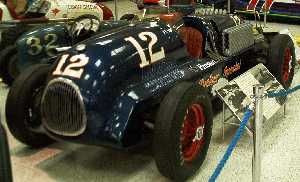
I can't stress too strongly how valuable and fascinating Roger Huntington's book really is to anyone interested in automotive technological development, especially in the way it developed within the auspices of the Indianapolis 500 through the decades. It's the kind of book that, once you start into it, you can't put it down, because it has so much to tell that so few folks today know about, but should. Did you know that a 16-cylinder two-stroke, supercharged, four-wheel-driven racer was entered in the 1931 Indianapolis 500? Or that a Grand Prix Maserati won the Indianapolis 500 in 1939 and 1940, and a prewar Mercedes Benz W154 GP racer was smuggled into the USA after the war and qualified on the second row of the '46 Indy 500? Or that Peugeot Indy racers were so popular with fans at the 500 in the pre-WWI years (Peugeot won the Indianapolis 500 in 1913, and they were front-row qualifiers until WWI) that, when Peugeot ceased their participation in 1916, the owners of the Indianapolis Motor Speedway contracted a local automaker (Premier) to build Peugeot replica racecars?
This book is a mind-expander, fersure. It's always so much fun, as an automotive enthusiast, to read about something that makes you say to yourself; "Well, I'll be damned; I never knew that!". Get this book.
The Miller/Gulf 4WD Special of 1939 evolved into a joint project between Miller (following Gulf Oil's cancellation of sponsorship) and Preston Tucker, later to become fairly famous as a failed carmaker. Tucker was deeply involved in the Indy 500 for many years, and he financed the Miller car to the extent that Miller was able to do some more development work on the car, thus the difference in appearance. Alas it all came to naught, but is still a colorful chapter in motorsports history. As far as I've been able to gather, the last time this car raced at the Speedway was the 1947 Indianapolis 500, when it was entered by Tucker. It dropped out of the race on the 33rd lap with magneto failure. It was first raced as a Tucker/Miller entry in the 1941 500 (note that the Indianapolis 500 was not held during the war years, 1942-1945). The car was highly advanced and sophisticated, but its high technology came at the price of great weight, which made the car basically uncompetitive despite all of the technology in play. It was primarily an exercise in futuristic thinking that was hobbled by the inability to fully exploit the advanced thinking due to utter lack of developmental work that had occurred with it, coupled with the great weight of all the hardware contained within it. Just look at the disc brake photo above. These primitive versions of disc brakes look like they probably weighed a ton!

This car, just as with Tucker's own "48 Torpedo" sedan of legend, was largely a car out of its time. It arrived too soon to be appreciated and used to its full potential. BTW, Harry Miller was employed by Preston Tucker as an engineering consultant early in the Tucker's gestational period.
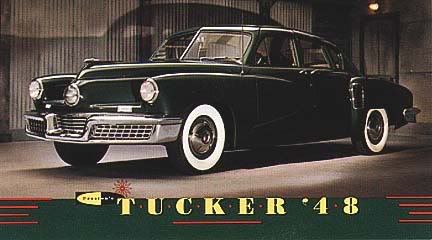
Here is a beautiful shot of one of the magnificent Millers at the Speedway Museum There are perhaps a dozen or so visits I've made to that place, and just kind of "camped out" and studied this car and the others for an extended time, just to drink in the sheer beauty of the things. The front-end, with its inboard brakes, gearbox, and everything else finished to a jewel-like standard are just something that photographs can't fully convey. Few modern racing cars look as "racy" as this 78-year-old machine, IMO. The proportions are perfection.
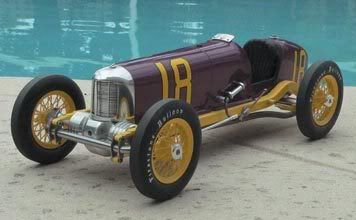
You are fake
ReplyDeleteEnjoyed the read. Thanks. Miller was amazing.
ReplyDeleteLoved reading this thannks
ReplyDeleteI find it fascinating how Harry Miller pushed boundaries with innovative designs like his four-wheel drive racing car.
ReplyDelete